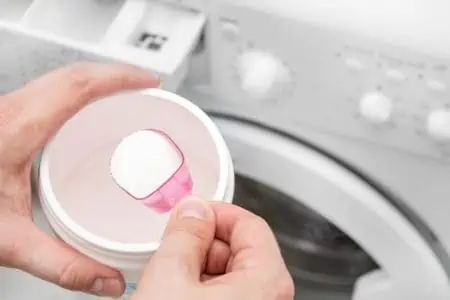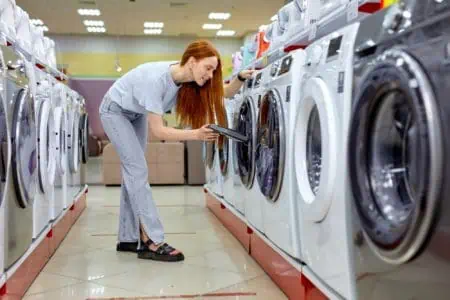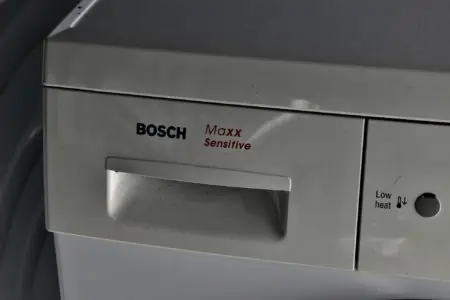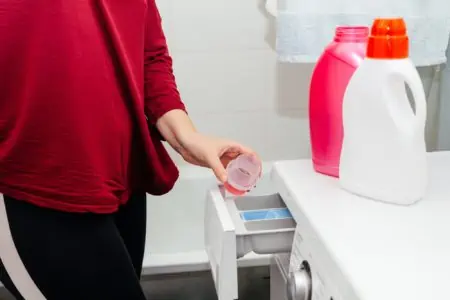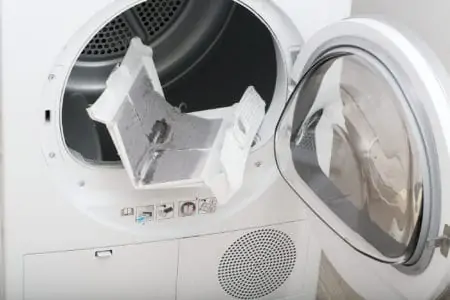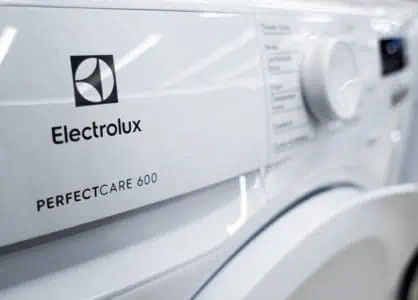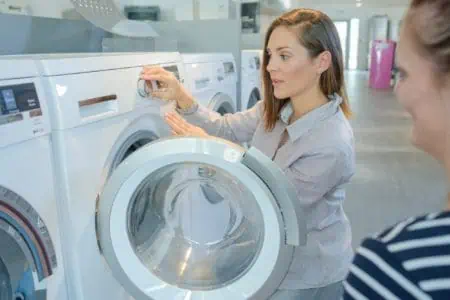Bleach: you either love it or you hate it. While it’s definitely effective at removing stains and whitening garments again, some people steer clear. Chlorine bleach is known for being toxic.
So what’s the deal? How do you use bleach in the washing machine as part of your laundry routine?
We’re here to answer that question. We’ll also walk you through the three main types of bleach, how to use them safely and effectively, top tips, and much more.
Consider this to be your ultimate guide for how to use bleach in your laundry regime.
Key Takeaways
- Use bleach safely in washing machines by following the correct dosages and checking the machine’s user manual.
- Know the different types of bleach: Chlorine Bleach, Oxygen Bleach, and Hydrogen Peroxide, each with unique properties and safety levels.
- Test for colorfastness before using bleach on clothes, and always dilute the bleach before adding clothes.
- Use bleach to clean your washing machine regularly, choosing the bleach type based on your preference and safety concerns.
Can You Use Bleach In a Washing Machine?
Bleach is safe for use in the washing machine as long as you use it correctly.
We recommend checking the washing machine’s user manual to ensure that the brand allows bleach usage.
Safety Warning
Never mix chlorine bleach with other products, especially ammonia or acid-based products. This can create toxic gasses (1).
Will Bleach Damage My Washing Machine?
Check the user manual before using bleach in your machine. If it allows for bleach, then it’s safe to do so, and following the correct dosage amounts, it will not ruin your washing machine.
Will Bleach Damage My Clothing?
Chlorine bleach is much more likely to damage your clothing than your machine.
You should always check the garment’s care label. If there is a blank triangle on the care label, it’s safe to use bleach. But if the triangle has a cross through it — don’t bleach the garment.
You can usually bleach these materials:
- Cotton
- Linen
- Rayon
- Polyester (for dying purposes)
You should also check color fastness. This ensures that the bleach will not damage the coloring of the garment. To do this, mix one teaspoon of bleach with two teaspoons of warm water.
Dip a cotton swab in the solution and blot the fabric in an inconspicuous spot, like an inside seam. Let the area dry completely. If there is no color change or color transfer on the cotton swab, it’s safe to bleach this garment.
You should do this with all three types of bleach, not just chlorine bleach. However, oxygen bleach and hydrogen peroxide are less likely to damage your clothes than chlorine bleach.
Different Types of Bleach
When using bleach in your washing machine and laundry routine, it helps to be aware of the three main types of bleach.
Here’s a chart to summarize the key differences.
| Features | Chlorine Bleach | Oxygen Bleach | Hydrogen Peroxide |
| What Is It? | Liquid sodium hypochlorite (NaOCI) (2). | Sodium percarbonate and hydrogen peroxide (3). | Water with an extra oxygen molecule (H202) (4). |
| Appearance | Clear thick liquid. | Usually a granular white powder. | Looks like water. |
| Strength | Very strong — it will whiten garments, remove stains and kill germs. | Strong — almost as good as oxygen bleach. | Strong — whitens, cleans and disinfects. |
| Safety | Safe when used correctly, but still toxic. | Safe for your clothes and skin, but may still irritate sensitive skin. | Safe to use but toxic when ingested. |
| How It Works | Bleach releases oxygen molecules. The oxidation process breaks up chemical bonds, which then reflects no color, which your eyes perceive as white (5). | It releases oxygen when mixed with water — this oxygen lifts stains and dirt (6). | The nascent oxygen in hydrogen peroxide works as a disinfectant (7). It also converts colored compounds to colorless compounds. |
Chlorine Bleach
When you hear the word bleach, this is probably what first comes to mind. Chlorine bleach is a chemical called liquid sodium hypochlorite. It’s a clear thick liquid that is extremely strong.
In one sense, that’s good because it removes stains and kills germs. Therefore, it’s very effective at cleaning.
However, many people avoid using it in their homes because it is toxic. It’s not safe to breathe in, and it’s very irritable on your skin. When you use it correctly, it shouldn’t harm you, though.
It works by releasing oxygen molecules through a process called oxidation. When it touches your clothes, the bleach breaks up the chemical bonds to reflect the absence of color, which our eyes perceive as white. Pretty neat, huh?
Oxygen Bleach
If you’re trying to eliminate the use of chemicals in your home, you may love the sound of oxygen bleach. It’s as effective as chlorine bleach in many ways. In fact, when using it correctly, you may be able to eliminate the need for chlorine bleach once and for all.
Oxygen bleach is a mixture of sodium percarbonate and hydrogen peroxide. It usually appears as a white granular powder that you can use in various areas of the home, including laundry.
It’s safer for you, but if you have sensitive skin, you might still find it irritating. In that case, wear gloves.
It works to clean by releasing oxygen when you mix the powder with water. This oxygen process works to remove stains and dirt and even whiten clothes again.
We love oxygen bleach because it’s safe for colored clothes and white clothes! It works beautifully at removing stains from yellow, blue, and orange clothes and sheets — plus more colors.
Hydrogen Peroxide
Another item you might already have in your cupboard that can work as a safe bleach alternative is hydrogen peroxide. It looks similar to bleach, but it’s much safer for you.
Just be sure you’re using a three percent solution for household use. This is how it’s usually sold, but always double-check.
Hydrogen peroxide is a strong cleanser. Use it to clean, to whiten clothes, and to disinfect. It has nascent oxygen in it, which works as a disinfectant.
The solution also works a bit like bleach in that it turns colored compounds to colorless compounds. That’s what makes it so great at removing stains.
How to Use Bleach In Washing Machine
Now that you know our main safety tips, let’s walk you through how to use these cleaners in your machine.
These instructions will restore your white clothes and also eliminate pesky stains.
We’ll go through all three types of bleach so that no matter which one you’re opting for, our method can help you.
- Time: 1-2 hours
- Difficulty: Intermediate
What You’ll Need:
- Bleach of your choice (chlorine, oxygen or hydrogen peroxide)
- Cotton swab
- Measuring cup
- Laundry detergent (with no ammonia or acid)
- Gloves (optional)
1. Test for Colorfastness
You don’t want to damage your clothes. So before using bleach in your washing machine, always do a colorfastness test.
To recap, mix one teaspoon of bleach with two teaspoons of warm water. Dip a cotton swab into the mixture and dab onto an inconspicuous spot of the garment(s) you’ll be cleaning. Let it dry completely and ensure no change in color or color transfer onto the swab.
2. Add Laundry Detergent
We know we said not to mix bleach with other cleaners, but it’s normally safe to mix bleach with laundry detergent. Make sure the detergent doesn’t contain any acids or ammonia.
Next, read the detergent instructions to ensure the manufacturer ensures it’s safe to mix with bleach.
Also, read your bleach’s packaging to ensure it’s also safe to mix with detergent. For oxygen bleach and hydrogen peroxide, it usually is, but you should always triple-check in the case of chlorine bleach.
Once you’ve determined it’s safe to use laundry detergent, add it to your machine via the detergent dispenser.
3. Add Bleach
Now, it’s time to add your bleach. The instructions will vary depending on the type of bleach you’re using and the packaging instructions. So always check them first.
For chlorine bleach, you may have to dilute it in a bit of water first. In a top loading machine, fill the drum up with water before adding the bleach. Use the hottest water possible according to your clothes’ care labels.
The amount of bleach you should add depends on the brand you use. For instance, Clorox recommends ⅓ cup for stain removal for standard machines or the max line on your dispenser for high-efficiency washing machines.
For front loading machines, add the bleach to your bleach dispenser, and it will automatically get diluted during the cycle.
For oxygen bleach, you can add the powder to the drum of your front loading machine before adding your clothes. For top loading machines, follow the same instructions for adding chlorine bleach. Don’t ever pour oxygen bleach directly onto clothes, as this can clean them unevenly.
If you have liquid oxygen bleach, you can add it to your machine’s bleach dispenser.
Last but not least: hydrogen peroxide. Pour one cup into the bleach dispenser for front loading machines. For top loading machines, add one cup to the washer water before adding your clothes.
4. Add Your Clothes
Now, you can insert your clothes into the machine. For top loading machines, we recommend wearing gloves since to submerge the clothes, you might need to get your hands wet.
For front loading machines, you can put the clothes into the drum without touching any bleach.
5. Set the Cycle and Begin
Choose a regular cycle with the hottest water possible. For instance, if your care labels suggest a variety of temperatures such as 100 degrees and 140 degrees, use the 100 degrees setting. 140 degrees could damage some of the garments.
Begin the cycle and let the bleach brighten your clothes!
Add an extra rinse cycle if you’d like. This ensures all the bleach residue is washed away.
How Much Bleach to Add to Laundry
This all comes down to the brand you’re using and the type of bleach.
When learning how to use bleach in your laundry routine, always refer to your manufacturer’s instructions.
For instance, Clorox suggests ⅓ cup for normal soil levels and ⅔ cup for heavy soil levels when washing clothes in a standard machine. They suggest filling to the maximum line in your bleach dispenser when using a high-efficiency machine.
OxiClean — a big seller of oxygen bleach — has its own measuring cup included. They recommend filling to line two for regular loads and adding more for larger loads. They don’t specify how much “more” is, which can be confusing.
For hydrogen peroxide, we recommend adding one cup per cycle.
Tips For Using Bleach In a Washing Machine
Let’s recap some of the most important tips for using bleach in your washing machine:
- Use hot water: Use the hottest temperature possible according to the garment’s care label. This makes the bleach more effective.
- Use correct detergent: Make sure it’s safe to use detergent alongside your chosen bleach. Read the manual carefully. Ensure the detergent has no acids or ammonia.
- Wear gloves: If using chlorine bleach, it’s imperative to wear protective gear. If you have sensitive skin, we recommend gloves when using oxygen bleach and hydrogen peroxide, too.
- Never mix bleach: Never mix chlorine bleach with other cleaners, especially acidic or ammonia-based products. This includes distilled white vinegar. This combination can create toxic gasses.
- Add bleach before clothes: Don’t let undiluted bleach touch your clothes. Always dilute the bleach first in a top loader or add it to the dispenser in front loaders. Undiluted bleach can damage your clothes and bleach them unevenly.
- Read the product packaging: There may be some extra tips depending on the brand you use, so always read the brand’s warnings before getting started. For instance, you can’t use most oxygen bleach products on silk, wool, or leather since it can weaken the fibers.
- Use fresh bleach: Don’t use expired bleach or bleach that’s been opened on a shelf for a while. After about six months, bleach can lose its effectiveness, and it might not work well.
- Don’t use chlorine bleach too often: While chlorine bleach is safe when used correctly, repeated use can cause yellowing and wear down fibers. Only use it when necessary.
- Keep away from children: You may be using bleach as safely as possible, but kids can still make mistakes. So always keep bleach out of their reach and don’t let them nearby when you’re bleaching clothes.
How Often Should You Use Bleach to Clean Clothes?
As mentioned, using bleach — especially chlorine bleach — too regularly can damage clothes. It can yellow them and weaken the fibers.
There’s no set rule as to how often you should use bleach, but we recommend limiting it to only when necessary.
You can use oxygen bleach and hydrogen peroxide more often. In fact, you may be able to use oxygen bleach in every load of laundry, depending on the brand you use.
How to Clean a Washing Machine With Bleach
We wouldn’t be answering all your questions if we didn’t explain how to use bleach in cleaning your washer. You should aim to sanitize your washing machine every month, and bleach is excellent for this task.
Good news, you can use any of the three types of bleach to do this! So if you’re still looking to cut out toxic ingredients, you can skip the chlorine bleach here.
- Time: 1-2 hours
- Difficulty: Easy
What You’ll Need:
- Bleach of your choice (chlorine, oxygen or hydrogen peroxide)
- Water
- Two cloths
- Rubber gloves (optional)
1. Mix Cleaning Solution
Follow the manufacturer’s instructions for how to safely dilute your chosen bleach in a bucket of water. You only need a little bit — this will be for cleaning the gasket. Wear rubber gloves if using chlorine bleach or if you have sensitive skin.
2. Clean Rubber Gasket
Dip a cloth into your diluted bleach, wring it out and clean the rubber gasket. This will not get thoroughly cleaned in the main wash cycle, so you need to do it by hand.
3. Add Bleach to Main cycle
For a front-loading washing machine, add your bleach to the detergent drawer. For oxygen bleach, you can add it directly to the drum. Set the machine to a regular cycle with the hottest water possible. If your machine has a drum clean cycle, use that.
For top-loading washing machines, fill the machine with the hottest water possible on a regular wash. Add your bleach to the water while it’s filling.
With both front loading and top loading machines, let the wash cycle commence. The bleach will work its magic to deep clean your washing machine.
With chlorine bleach and hydrogen peroxide, it will sanitize your machine, too. Oxygen bleach does not work well for sanitizing, but hot water can kill germs during this process, so it’s still an effective choice of bleach.
4. Rinse and Dry
FAQs
Bleach Recap
Since you came here wondering how to use bleach in your washing machine, we hope we’ve answered that for you.
It’s definitely possible to use bleach in your laundry routine. But you should always follow safety precautions. Wear gloves, read the care label and never use too much bleach.
If you’re not a fan of toxic chemicals — oxygen bleach and hydrogen peroxide are fantastic alternatives! They will clean your clothes, sheets, and more while removing stubborn stains.
